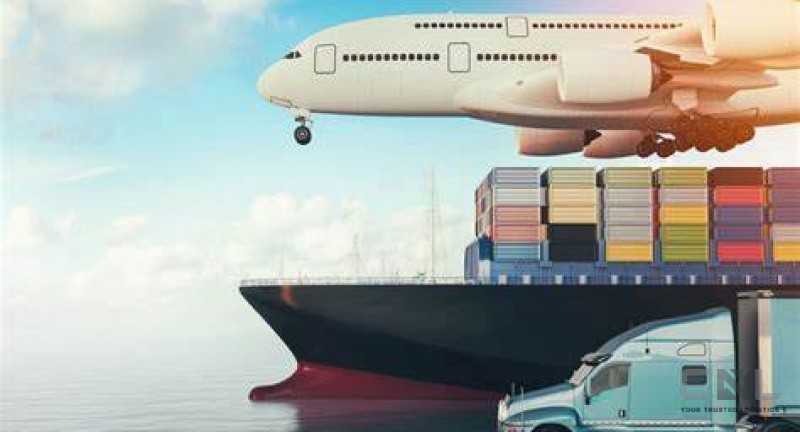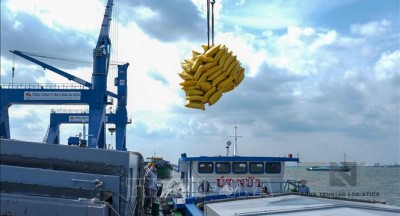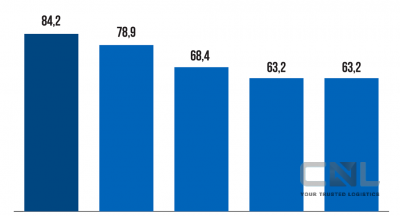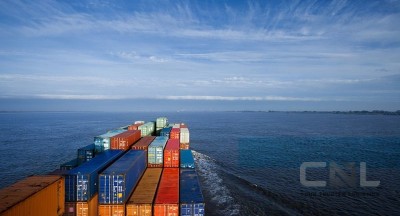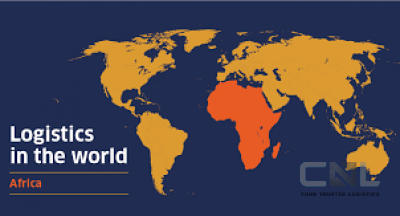In the first months of 2022, the global logistics market continues to recover and enters a new phase with the expectation of bringing significant growth for both 2022 and the next period. However, in the face of risks from the Russian-Ukrainian war tensions, the outbreak of the disease in China... is raising the risk of global supply chain disruptions, affecting logistics activities. In the face of complicated developments on a global scale, there are still many difficulties in the short term, requiring logistics businesses and shippers to continue to adjust supply chain and logistics models.
Global logistiscs market in the first months of the year
In the first months of 2022, the global logistics market continues to recover, but difficulties have not abated due to the tensions of the Russian-Ukrainian war, epidemics, inflation and rising oil prices... In Europe, the impact of inflation on the supply of the regional freight market, particularly diesel prices, has led to a significant increase in transport costs in the first quarter of 2022.
The restriction of oil supplies from Russia to Europe adds to the pressure on freight rates and other production and business costs. The weighted average price of a litre of diesel across the EU has risen sharply (the weighted average cost of diesel in the first quarter of 2022 increased by more than 52.7% compared to the lowest of €1.10 in the second quarter of 2020) which has affected logistics operations. Facing that situation, on 23/5/2022, the European Commission had to adopt a Contingency Plan for Transport to strengthen the resilience of the transport sector in times of crisis, thereby minimizing the risk of supply chain disruption as in nearly 3 years of the COVID-19 pandemic.
In the United States, data from the US Transportation Statistics Agency (BTS) shows that the country's freight services index (TSI) in March 2022 increased by 0.7% compared to February 2022. The Logistics Manager index fell to 69.7 points in April 2022, the lowest level since January 2021, after reaching a record 76.2 points in March 2022 due to a decrease in key component indicators.
Currently, in the country's market, some positive signals were recorded in the truck transport market in May 2022 when COVID-19 control measures were relaxed. However, fuel costs are a big negative factor for the index of truck transport in particular and the logistics sector in general...
According to data from China's National Statistics Office, in the first 4 months of 2022, the country's shipping by water reached 2.63 billion tons, up 4.2% over the same period in 2021. In the first 4 months of 2022, the volume of cargo through Chinese ports was 4,905 million tons, up 0.26% over the same period in 2021, the volume of containers through Chinese ports was 91 million TEU, up 1.7% over the same period in 2021. According to the publication of the China Purchasing and Logistics Federation, the country's logistics industry development index in April 2022 was 43.8%, down 4.9 percentage points compared to the previous month; China's warehousing index was 46.5%, down 0.4 percentage points from the previous month...
In South Korea, the Korea Transport Price Index increased from 109.11 in January 2022 and to 119.2 in April 2022. In addition to the impact of the price index, the country's logistics activities in the first months of the year were also affected by the strikes of workers in the Korean transport sector that took place in June 2022. In Singapore, in April 2022, the total container traffic through Singapore ports reached 3.04 million TEU, down 1.54% compared to March 2022 and down 1.59% compared to April 2021. Generally, in the first 4 months of 2022, the total container traffic through Singapore ports reached 12.11 million TEU, down 2.48% over the same period in 2021...
Factors impacting the global logistics industry in 2022
Many forecasts indicate that, in 2022, supply chain and logistics enterprises will continue to be under great pressure because of resource constraints, skyrocketing transportation costs, geopolitical conflicts... In particular, there are some key factors affecting the logistics and supply chain sector in 2022 and the upcoming short-term period:
- Demand for imported consumer goods increases: Due to the COVID-19 pandemic starting in 2020, consumers' spending needs for durable goods such as household appliances, clothing... increasing, putting pressure on global supply chains and logistics activities when they have not served and responded in time.
- Imbalance in cost: The current logistics infrastructure is not keeping up with freight demand, creating a serious decline in capacity at ports and the entire last-mile distribution route. Labor shortages also make importers and logistics enterprises unbalanced in saving costs and transporting efficiently. In addition, the ability to circulate goods is hampered by the shortage of sea containers.
- Geopolitical Conflict: In the context of ongoing conflicts, with sanctions between countries, many shipping enterprises are facing great challenges in trade partnerships. They must screen partners for compliance with export regulations to simplify business operations. In addition, in the face of the trend of gasoline prices in particular and inflation in general, businesses will have to find alternative sourcing to minimize risks.
- Sustainable development: With more and more countries directing consumers and businesses to act on the environment, supply chains and logistics need to play a leading role in efforts to reduce greenhouse gas emissions. Therefore, logistics enterprises need to actively promote the improvement of operational processes, invest in technology to improve supply chain performance always in tandem with improving the environment, reducing CO2 emissions...
- Labor supply shortage in the logistics industry: This is a growing concern. According to data from the International Shipping Office (ICS), along with the Philippines and China, India is one of the world's largest seafarers suppliers with about 240,000 of the more than 1.6 million seafarers globally today. The fact that seafarers from this country are infected with COVID-19 makes the shipping industry face the prospect of all seafarers on infected ships having to stop the operation of these ships.
The situation could come as a shock to the shipping industry, which accounts for 80% of global trade. Or as the shortage of drivers continues to affect road transport capacity, disrupting the flow of goods. According to the American Trucking Association, America's current driver shortage is 80,000, with a projected shortage of more than 160,000 drivers by 2030. Over the next decade, the trucking industry will need nearly a million new drivers to bridge the gap between freight demand, retired drivers and other supply chain pressures. The shortage of labor supply will be a big risk and a strong impact on global logistics activities, despite digitalization efforts because there are still many stages and stages that require human participation.
Implications for Vietnam
Despite facing many difficulties due to the COVID-19 pandemic, Vietnamese logistics enterprises still stand firm, contributing to maintaining and stabilizing the supply chain, ensuring positive economic growth. However, Vietnam's logistics industry still reveals some limitations such as: high costs, links between logistics enterprises as well as weak manufacturing and exporting enterprises; digital transformation in the industry is slow... According to data from the Vietnam Logistics Business Association, currently 90% of logistics enterprises in operation are Vietnamese enterprises, but only account for about 30% of the market share, the rest belong to foreign enterprises. The number of enterprises is large but mainly small-scale, limited in both capital and human resources as well as international operating experience, there is no link between the stages in the logistics supply chain and between logistics service enterprises and import and export enterprises. Therefore, in both buying and selling directions, domestic logistics enterprises are limited in terms of playing field.
In 2022, it is forecasted that there will continue to be many difficulties and challenges for the logistics industry, requiring Vietnamese logistics enterprises to make more efforts, strengthen intra-regional links to continue to overcome challenges and rise worthy of the role of an important service industry in the economy. According to the Master Strategy for the development of Vietnam's service sector in the period of 2021-2030, with a vision to 2050, for the logistics service sector, the Government orients the use and investment in the development of transport infrastructure and organizes propaganda to encourage enterprises to improve their capacity, quality of logistics services. Establish a multi-level network of distribution centers (dry ports, warehouses, cargo yards) and transport routes to collect and collect goods in large urban areas and key economic regions. In addition, focusing on developing high-quality human resources for transportation and logistics services to meet domestic and international needs.
On the basis of the global and Vietnamese logistics activities associated with the successful implementation of the Overall Strategy for the development of Vietnam's service sector in the period of 2021-2030, with a vision to 2050, including the logistics service sector, the author proposes the following contents:
For regulatory bodies
- Continue to improve policies and laws on logistics and transportation services. Accordingly, amending a number of regulations and supplements on logistics and transportation services in the Commercial Law, creating a favorable legal basis for logistics activities. Amending and promulgating new policies and laws governing logistics services, multimodal transport and cross-border transport. Comprehensive coverage of logistics services, internalization of international commitments on logistics ...
- Connecting information technology in logistics, especially customs procedures and at the border (strengthening organization, promoting standardization in exploitation such as documents, technology standards ...), developing logistics portals, EDI, e-logistics ...
- It is necessary to continue mobilizing all resources to renovate logistics infrastructure, gradually modernize transport infrastructure and logistics centers in accordance with national and regional economic development plans. Handling supply chain bottlenecks such as the productivity of seaports, dry ports, inland waterways, warehouses and transshipment points; multimodal transport planning promotes the rapid development of low-cost freight transport modes...
- Renovate the mechanism to attract investment in the field of logistics infrastructure because there is currently a lack of attractiveness, no incentives, even incentives by investment in industrial parks. Encouraging private investment, enterprises and public-private partnership (PPP) model...
- Promote reduction and simplification of administrative procedures and specialized inspections; promote promotion activities through trade connection activities (including online), host and attend important conferences and exhibitions of the international logistics industry.
For businesses
- Implement solutions to reduce logistics costs; Widely apply supply chain management, logistics management in enterprises.
- Develop a variety of distribution centers in major cities and cities across the country to serve the retail market, logistics centers near industrial parks for production and export processing.
- Logistics restructuring, which promotes the development of logistics types (3PLs, 4PLs, 5PLs) in the country, considering this as a premise for developing Vietnam's logistics market.
For training institutions
- Focus on training human resources in logistics, maritime transport ... Accelerate the training of logistics professionals with applied skills and implement logistics and supply chain management practices to keep up with industrialized countries...
- Innovating content and teaching methods in the direction associated with the practice of enterprises and the development trend of logistics services in the world.
Bibliographic references:
1. The Prime Minister (2021), Decision No. 531/QD-TTg approving the Overall Strategy for the development of Vietnam's service sector in the period of 2021-2030, with a vision to 2050;
2. Ministry of Industry and Trade (2021), Vietnam Logistics Report 2021;
3. Ministry of Industry and Trade (2022), ASEAN logistics market report No. 5/2022;
4. Ministry of Industry and Trade (2022), China logistics market report 5/2022;
5. Ministry of Industry and Trade (2022), US logistics market report No. 5/2022;
6. Thanh Thu (2022), 5 factors affecting the global logistics industry in 2022, Vnexpress.net;
7. Global logistics trends 2022. Access link: https://innovativehub.com.vn/xu-huong-logistics-toan-cau-2022.
*MSc. Bui Thi Hang - University of Transportation Technology
** Publication in Financial Magazine 1st term - 7/2022
